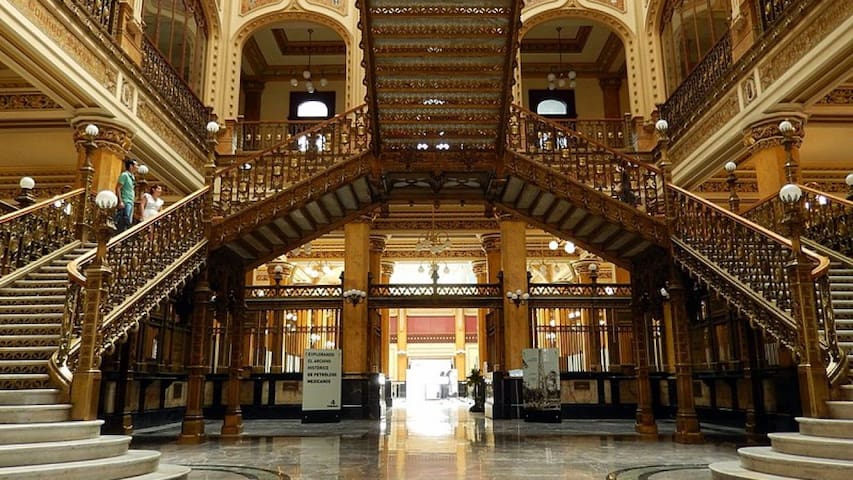Sightseeing
This park is just 10 minutes walking distance. It´s the first public park to exist in Latin America and dates from the late 18th Century. Since then, it´s had many changes but you´ll enjoy the many Art Nouveau statues that adorn it as well as the flora. Crossing it takes you to the Historic Centre (named World Heritage site by UNESCO).
338 (рекомендации местных жителей)
Аламеда Сентраль
s/n Avenida HidalgoThis park is just 10 minutes walking distance. It´s the first public park to exist in Latin America and dates from the late 18th Century. Since then, it´s had many changes but you´ll enjoy the many Art Nouveau statues that adorn it as well as the flora. Crossing it takes you to the Historic Centre (named World Heritage site by UNESCO).
This is one of Mexico City´s landmarks and you get to it by walking through the Alameda Park or subway (Palacio de Bellas Artes Station). Designed by Italian Architect Adamo Boari at the beginning of the 20th Century. It´s made entirely of Carrara Marble shipped in from Europe with inner Steel frame with Neoclassical style on the outside and Art Deco style on the inside. Here you can enjoy an Opera, Classical music, a ballet, speaking of which is the home of the National Folkloric Ballet that has performances every Wednesday and Sunday. On top of that, (literally) is a museum with a permanent exhibition of famous muralists like Diego Rivera, David Clemente Orozco and David Alfaro Siqueiros among other very talented Mexican Artists. There are usually transient exhibitions going on as well.
680 (рекомендации местных жителей)
Дворец изящных искусств
S/N Av. JuárezThis is one of Mexico City´s landmarks and you get to it by walking through the Alameda Park or subway (Palacio de Bellas Artes Station). Designed by Italian Architect Adamo Boari at the beginning of the 20th Century. It´s made entirely of Carrara Marble shipped in from Europe with inner Steel frame with Neoclassical style on the outside and Art Deco style on the inside. Here you can enjoy an Opera, Classical music, a ballet, speaking of which is the home of the National Folkloric Ballet that has performances every Wednesday and Sunday. On top of that, (literally) is a museum with a permanent exhibition of famous muralists like Diego Rivera, David Clemente Orozco and David Alfaro Siqueiros among other very talented Mexican Artists. There are usually transient exhibitions going on as well.
This is another building by Italian Architect Adamo Boari, who designed the Palace of Fine Arts just across the street. It´s from the same time period but has an ecclectic design with a fusion of Medieval, Gothic Venetian, Mudejar and Plateresque. A magnificent Palace that shouldn´t be ignored. It´s still a Post office so take advantage and send a post card!
99 (рекомендации местных жителей)
Паласио Postal
1 Calle de TacubaThis is another building by Italian Architect Adamo Boari, who designed the Palace of Fine Arts just across the street. It´s from the same time period but has an ecclectic design with a fusion of Medieval, Gothic Venetian, Mudejar and Plateresque. A magnificent Palace that shouldn´t be ignored. It´s still a Post office so take advantage and send a post card!
This is another beautiful palace which was another elegant office like the Postal Palace dedicated to Transportation and Communication. With the evolution of the train and the telegraph this special office was devoted to these modern advancements. Also designed by an Italian Architect, Salvatore Conti, it´s breathtaking European design makes it a must see. Also, it is now an Art Museum housing the largest collection of New Spanish Art as well as other European and Mexican Painters.
300 (рекомендации местных жителей)
Художественный музей Museo Nacional De Arte (MUNAL)
8 Calle de TacubaThis is another beautiful palace which was another elegant office like the Postal Palace dedicated to Transportation and Communication. With the evolution of the train and the telegraph this special office was devoted to these modern advancements. Also designed by an Italian Architect, Salvatore Conti, it´s breathtaking European design makes it a must see. Also, it is now an Art Museum housing the largest collection of New Spanish Art as well as other European and Mexican Painters.
The National Palace is where the President resides. This is found in the very heart of the city called the Zocalo. Not far from the other Palaces I´ve suggested. It has been a Palace of Presidential officials or Viceroys since the Conquest in the 16th century. It also houses Diego Rivera´s most important works. There are tour guides always available to show you around.
89 (рекомендации местных жителей)
Национальный дворец
S/N P.za de la ConstituciónThe National Palace is where the President resides. This is found in the very heart of the city called the Zocalo. Not far from the other Palaces I´ve suggested. It has been a Palace of Presidential officials or Viceroys since the Conquest in the 16th century. It also houses Diego Rivera´s most important works. There are tour guides always available to show you around.


